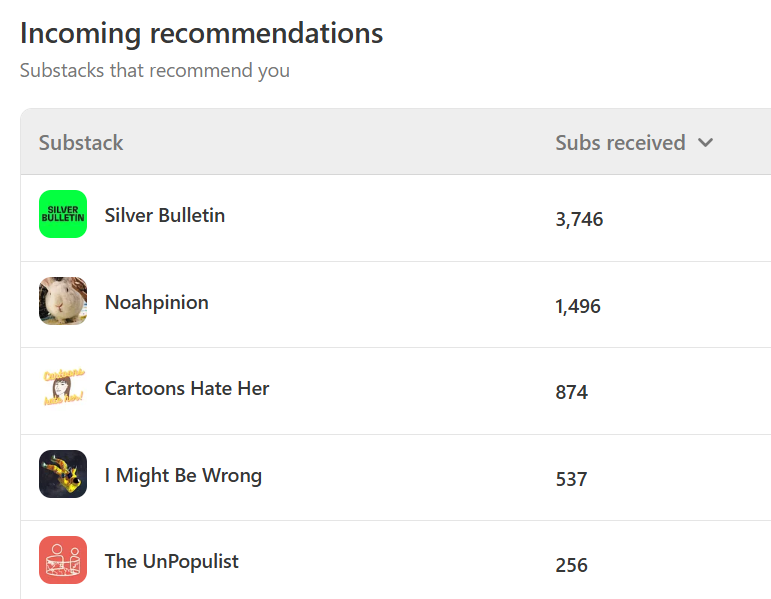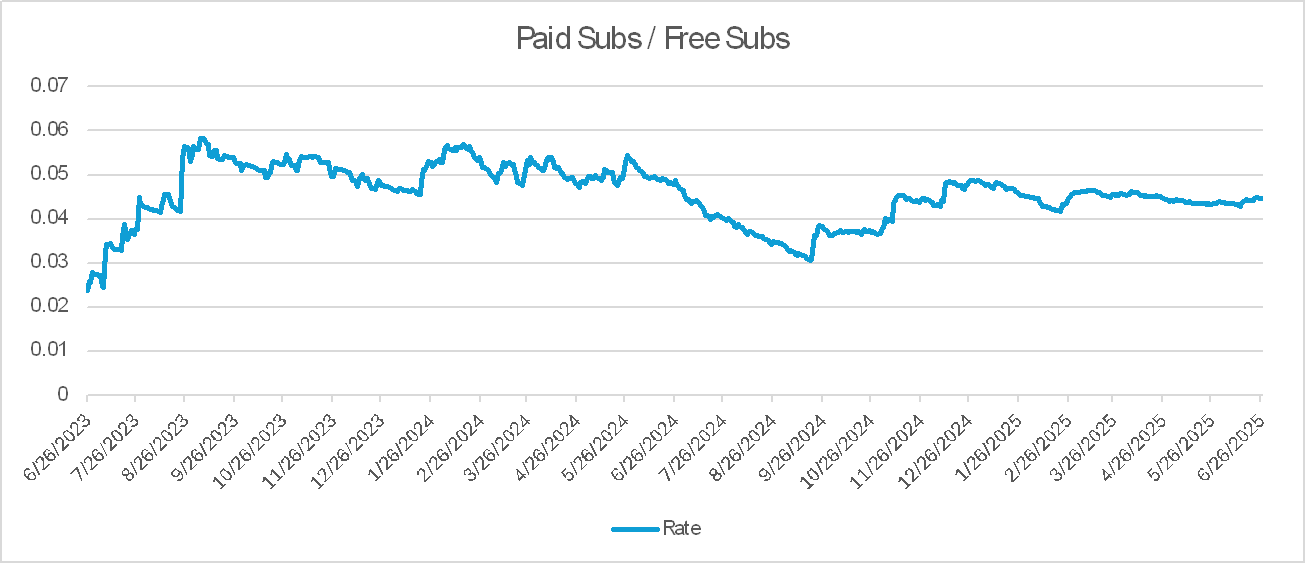Two Years of Scrolling
Recapping two years of Infinite Scroll - with stats and graphs!
Last month, Infinite Scroll celebrated its two year anniversary. Because I’m a nerd at heart, I like to share a bunch of statistics and charts on how the blog is doing. I wrote a similar post last year on the site’s first anniversary, and it’s time to do so again.
Radical transparency! See behind the curtain! This is an opportunity to talk about how things work on Substack, a site that’s becoming increasingly important to online discourse. But it’s also an opportunity to talk about myself, which is increasingly important to my habit of self-aggrandizement. I like to think I’m clear eyed enough to recognize where I’m at in the online hierarchy - pretty clearly successful compared to a typical blog, but still far short of the top 1% of mega-influential writers. So hopefully this is interesting and useful data about what mid-level success on Substack looks like.
Subscribers
First, a graph of free subscribers over time:
At the one year mark, I had around 2,400 free subscribers. At the two year mark, I had around 10,300. More than quadrupling in a year is a pretty solid year! The rate of growth increased from year one to year two, and despite a recent slowdown I’m pretty happy with how free subscriber growth has gone for the past year.
There are some interesting trends you can pull out from this data. What caused the accelerated rate of growth? One big factor was being recommended by Nate Silver:
Substack’s recommendation engine is far more powerful than I’d expected - almost half my free subscribers have come from two large blogs that recommend Infinite Scroll. And as Nate experienced huge growth because 2024 was an election year, some of that growth ended up being directed my way. Beyond that, I think the general political atmosphere of late 2024 helped quite a bit - this is mostly a blog about the social internet, but I often can’t help myself and end up Doing Viral Politics Stuff by accident. And you can see that on the graph!
The two visible bumps you can see on the graph above are from my appearance on Jon Favreau’s podcast Offline (by far the most subscribers I’ve ever gotten from a media hit), and from a viral article about JD Vance’s vice signaling. It’s hard to know ahead of time what’s going to get huge engagement and what’s not, but political posts are pretty reliably more popular and more likely to go viral than non-political posts.1
Another thing that exploded this year was the ‘follower’ count on Substack. If you’re not aware, Substack has two ways to follow a blog - following and subscribing. Subscribers get every post emailed to them, while followers just occasionally see posts when they open the app. Subscribers are much, much more valuable for writers than followers. But followers aren’t completely insignificant, and as Substack transitions into being more of a social network they’re coming to dominate the app:
Almost 50,000 followers sounds amazing, but the vast majority of them don’t see the vast majority of Infinite Scroll posts, so I view them as empty calories. If you’re a follower reading this, subscribe!
Monetization
Free subscribers are important! But to repeat a phrase from last year’s post - another thing that’s very important, just to me personally, is money.
Paid subscribers increased from about 110 at the end of year one to about 450 at the end of year two. This shows about the same level of growth as we saw in free subscribers, slightly over quadrupling in a year. That’s because the ratio of paid subscribers to free subscribers is remarkably stable over time:
About 4-5% of subscribers will be paid subscribers at any given time. This fluctuates, but doesn’t seem to have changed by very much since the early days of the blog. This is one of the reasons I’m focused on free subscriber growth - over time, it seems to inexorably lead to paid subscribers.
What does this mean for income? Theoretically you could just multiply (Price * Number of Paid Subs * 12) and get a yearly income. In practice, it’s not that simple of a calculation. First, there’s the cut that Substack and Stripe take:
As I wrote last year:
On a typical $8 payment, the Substack author will see $6.67 of that. I don’t begrudge that - 10% is a reasonable fee for Substack creating the entire site and network I’m using. Stripe is likewise fine. But it does mean less coming my way.
There’s also the issue of discounts. Many users get a discount by paying annually rather than yearly, or take advantage of some other limited time discount offer I ran. Users can also drop in or out of being subscribed, and some of those in the ‘paid’ tier are either comped or gifted. So in practice this stuff is complicated.
My best guess is that for the calendar year 2025, I will end up making around $35-$40K from Substack. This is compared to about $10K from the calendar year 2024. It’s not yet at the level of being full-time professional salary, but if the blog keeps growing then we’ll be in a good place in a year or two. To all my paid subscribers, I can’t thank you enough for making the blog possible.
Zooming in, most of the growth in paid subscribers occurred from September 2024 to March 2025. I couldn’t tell you why those months in particular, but that time period saw the blog go from around 175 to around 450 paid subscribers. But after a big jump in March, growth has been relatively flat for the past three months. Concerning? Maybe! Other writers I’ve talked to have said that fluctuations like this aren’t all that unusual. We’ll see if it keeps up for much longer.
Posts
How does a typical post on Infinite Scroll perform?
If we go back to the very early days, a typical post would get 500-1000 views:
At around a year’s time, the floor for a typical non-viral post was around 2,000 views
After two years of the blog, the typical post now gets around 8,000 views. Open rates have declined over time, which I think is somewhat natural as the blog gets larger.
There’s variation - paid posts obviously get significantly fewer views, and podcast episodes are slightly less viewed than regular posts. Weekly Scroll posts are dependable, but rarely go viral. The more thinkpiece-y posts sometimes do go viral - the high end seems to be around 40-50,000 views for pieces like How Gay Marriage Ruined Democratic Activism. As I mentioned above, politics-heavy posts are more likely to get traction than pure internet culture posts.
What’s Next?
Last year I wrote:
The purpose of this blog has come into focus over the past year. My goal is to do two things:
Recap all the most interesting things happening on the social internet - whether they be important, trivial, funny or horrifying.
Help people understand the social internet better - why do people behave they way they do? Why is one site flourishing while another dies? Etc.
Weekly Scroll series mostly focuses on the first - tales from around the internet, identifying the trends, patterns and news from the week that explain what’s going on online. There are a lot of people out there who enjoy a good dose of online storytelling or nonsense, but don’t have the time to obsessively follow it because they’re healthy human beings and not stunted internet goblins. That’s a great reason to follow along here. I’ve been the internet goblin this whole time.
The midweek pieces tend more towards the second point. In all humility, I do think I understand the nature of social internet communities and how people behave in those social communities better than almost anyone else writing about this stuff. People are endlessly fascinating. When you stuff them into artificial virtual environments, drown them in engagement bait and culture war posts and let them loose, they’re even more fascinating. And I think it’s important to understand how these social media systems influence us and how people are navigating them as groups and as individuals.
I like to think that I’ve done a pretty good job covering this stuff over the last year. Whether it’s pieces about the nature of online video, why livestreamers go politically insane, or how new art is strangling old art, we’re digging in to how the social internet is changing the world. And the Weekly Scroll keeps you all up to date on the nonsense of the week, whatever it may be.
If you’re interested in this stuff like I am, you’re in the right place. So here’s my sales pitch - becoming a paid subscriber gets you access to the roughly 1 in 3 posts that are paywalled. If you’ve been on the fence, now is a great time to jump in. And just for you, I’m offering a special offer to celebrate two years.
For the next week, this link will give you 20% off a subscription to Infinite Scroll. Or click the button below:
Thanks for being subscribed to Infinite Scroll, and I can’t wait to see what kind of internet nonsense we get up to in year three.
Whether or not this is a healthy state of affairs for the social internet is an exercise left to the reader.











If this information is helpful, I am a paying subscriber because about 2 years ago I got rid of Twitter and all social media with it. I didn’t think it was good for my wellbeing. But I miss the discourse. How I miss the discourse. This gives me a good feel for what I’m missing without spending hours a day reading takes about why restaurants will be either banned or mandatory under socialism. Thank you for your service!
I really like this transparency and learning about the "business" of substack. Mostly because i really am coming to like this site and want to know this is sustainable (which it seems to be?)